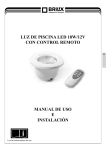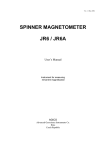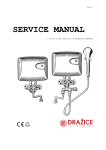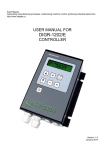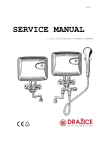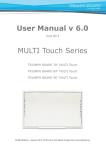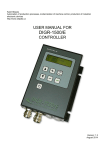Download Operating Instructions For ABO Triple Offset Butterfly Valves, Series
Transcript
Operating Instructions For ABO Triple Offset Butterfly Valves, Series 3 E 1. Introduction 2. Safety Instructions 3. Valve Model 4. Transportation and Storage 5. Installation into Piping 6. Pipe Pressure Test 7. Operation and Maintenance 8. Assistance in Case of Failure 9. Valves with Electric or Pneumatic Actuator 1. Introduction Triple-offset butterfly valves, Series 3E have been designed for very demanding industrial applications requiring high security and reliability. They are mainly used in heat generation industry and applications with high temperature mediums (up to 700° C and pressure up to 100 bar). The correct type and material design is determined using brochures and technical data sheets, or consultations with the manufacturer. Check valves of Series 3E are in full compliance with the directive CE/97/23. 2. Safety Instructions Installation, operation and maintenance may only be performed by properly trained and instructed staff. For detailed safety regulations see the separate document, which must be read carefully before installation. 3. Valve Model Valves come with a body with through holes (marked "B"), threaded holes (marked "T") of a flange or welded design. Inner diameter range: DN 80 to DN 700 Operating pressure: up to 100 bar Material design: Carbon steel Stainless steel Each butterfly valve is provided with an identification label in accordance with ČSN EN 19. Maximum and minimum operating temperatures TS max, TS min depending on the operating pressure PS for various material designs are listed in the charts included in the appropriate brochures. 4. Transportation and Storage Valves must be stored indoors in dry and dust-free environment at normal temperatures. Valves are stored in a slightly open position (never fully closed!). Valves must always be handled in keeping with all the safety standards: • Lifting and handling must be carried out by qualified staff, • Use lifting equipment with sufficient load-bearing capacity, including loops and ropes, • Three-point method of rope attachment (balancing) is recommended, • No part of the lifting system (loops..) may come into contact with the components of valve actuators. 5. Installation into Piping Butterfly valves may be installed in the piping system or at the end of the pipe. Prior to the installation it is necessary to check whether the PN, DN and material design of the supplied valve corresponds to the intended use. The procedure is graphically described in the document Installation Instructions. Flanges with flat sealing surfaces e.g. B shape according to EN 1092 and also appropriate gasket must be used. Before installation it is necessary to examine: • Whether the PN, DN and materials of the supplied valve correspond to the intended use. • Whether the valves are damaged, namely to the sealing surfaces of the disc, occurred during transportation. Do not use damaged valves! • Check the correct function of the valve (full opening and closing). • The flanges must have a gasket strip, and they must be aligned and parallel, any impurities and solid particles must be removed from the flanges and piping. When manufactured, valves with a carbon steel body are preserved using the oil preservative RUST-PEL 51. (If stored for more than 6 months, a new preservation treatment is recommended). Prior to putting into operation, the preservation of the valve body needs to be removed using a warm aqueous solution containing a common detergent or solvent such as E 550 CLEAN etc. A gasket made of a material resistant to the medium used is placed between the valve and the flange. The arrow on the body marks the direction of the flow (direction Δp). After centring the valve in the pipe, slightly tighten the 4 bolts and check if the disc moves freely. Tighten all bolts (“in a cross-cross pattern"). The heads of the opposite bolts in "T" type bodies must not be in touch! After re-tightening the bolts check if the disc moves freely. 6. Pipe Pressure Test The actual valve is pressurized by the manufacturer. When fitted in the pipeline the entire pipe section with valves needs to be pressurized. The following must be observed: • A newly installed section must be carefully rinsed (cleaned) to remove all mechanical impurities, • Valves in open position: pressure at 1.5 times the PN, • Valves in closed position: pressure at 1.1 times the PN. 7. Operation and Maintenance Valves can be manually controlled using normal force, it is not recommended to extend the length of the lever. When the lever is parallel to the pipe the valve is opened; the position of the lever perpendicular to the pipe means that the valve is closed. Opening and closing using the lever must be gradual rather than abrupt, to avoid hydraulic shock. The valves are maintenance-free, it is only necessary to check if the outer surface and the stem seal do not leak while in operation. If the valve remains in the same position for a long time, it is recommended to close and open the valve repeatedly at least 4 times per year. 8. Assistance in Case of Failure In case of failure and repair it is necessary to adhere to all safety rules, see the separate document Safety Instructions. 9. Valves with electric or pneumatic actuator The above principles fully apply to these valves. It is also necessary to observe and check the correct end position adjustment of the actuators. The positions of the actuators have been pre-set by the manufacturer and may not be adjusted. The intake (or exhaust) of controlling air in pneumatic actuators can be adjusted to avoid their quick closure and hydraulic shock in the pipes.





